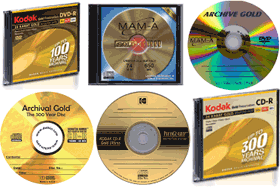Step 3 – Preparations and practice for reformatting
Introduction
"Reformatting" is the technical term for moving information from one media format to another. If the formats of electronic media, or the technologies to read the media, are becoming obsolete, then this step becomes a priority. Storage for several years without action will lead to information loss.
It is likely that all analog sound and video will eventually have to be moved to a digital format, which will lead to a need for high storage capacities for digital information. Sophisticated electronic information storage strategies such as the RAID (Redundant Array of Independent Discs) system, which includes multiple hard drives on which information is divided and replicated, are ideal. A RAID system offers the following advantages:
- high-capacity storage
- fast access to data
- protection against loss of information should one or two of the hard drives fail
Acquiring this type of high-capacity storage system is probably beyond the resources of most small museums in Canada at this time. As an interim solution, institutions can continue to use optical or magnetic tape storage media.
The effectiveness of this solution will depend upon the stability of the format chosen and how long the technology to play it remains available.
Choosing a standard file format
Reformatting information begins by selecting a suitable file format.

To be retroactively retrievable, digital information is best kept in standard file formats. Obviously, the fewer file formats that are used, the better. Standards bodies such as the International Standards Organizaton (ISO) are increasingly specifying standard file formats for text, audio and video information. For example, PDF is the format of choice for text files.
For more information on ISO file format standards, see ISO 19005-1:2005.
For more information on PDF formats, see PDF as a Standard for Archiving (PDF document).
Choosing electronic media
After being reformatted, the digitized information will need to be stored on new media. The options are:
- magnetic data tapes
- internal or external hard drives
- flash media
- optical discs
The medium chosen should be:
- widely used in the marketplace
- relatively inexpensive
- playable on a large variety of media and equipment
- standardized
- non-proprietary
- compatible between products of different manufacturers
For maximum stability, CCI recommends using stable media such as CDs or DVDs that have gold metal reflective layers. For CD-Rs, read the manufacturer's documentation to make sure that a stable dye, such as phthalocyanine, was used in the disc's manufacture. This type of disc can be purchased directly from several Internet suppliers or from standard conservation suppliers.
Many commercial companies will reformat analog audio or video materials and put them into CD, DVD or other digital media formats. You can also buy inexpensive equipment to do this in-house, such as the Panasonic DVD recorder, model number DMRES36V, which is used to digitize VHS tape to DVD.
Do test runs
Before adopting a specific approach, whether in-house or using an external service, make sure that the procedure causes minimal loss of image or sound quality on the finished product. Always conduct test runs to evaluate the quality of the reformatting before beginning a large-scale project.
Step 4 — Documentation is the final step in an electronic media preservation strategy.